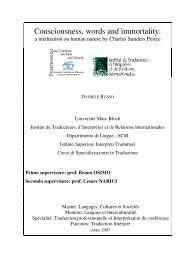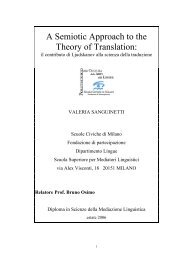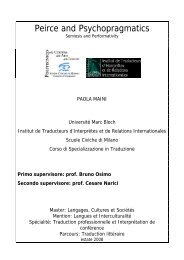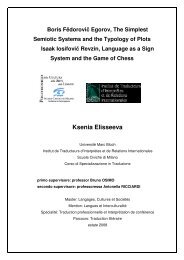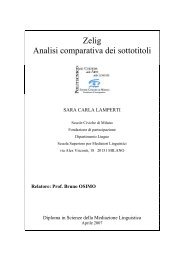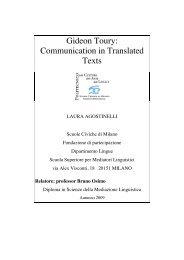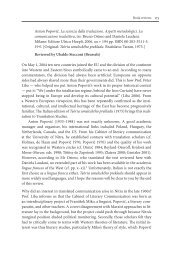Relatore: Professor Bruno OSIMO - Bruno Osimo, traduzioni ...
Relatore: Professor Bruno OSIMO - Bruno Osimo, traduzioni ...
Relatore: Professor Bruno OSIMO - Bruno Osimo, traduzioni ...
You also want an ePaper? Increase the reach of your titles
YUMPU automatically turns print PDFs into web optimized ePapers that Google loves.
Goffman uses the notion of role distance ‘to refer to [the] actions which<br />
effectively convey some disdainful detachment of the performer from a role he<br />
is performing’ (1961: 110). In contrast, attachment to a role is described as<br />
follows (1961: 89)<br />
The self-image available for anyone entering a particular position<br />
is one of which he may become affectively and cognitively enamoured,<br />
desiring and expecting to see himself in terms of the enactment of the<br />
role and the self-identification emerging form this enactment.<br />
As a rule, people are attached to the roles they perform regularly. In fact,<br />
Goffman points out that it is considered to be ‘sound mental hygiene for an<br />
individual to be attached to the role he performs’ (1961: 89f.). However, on<br />
some occasions it may be equally necessary, partly in terms of ‘mental<br />
hygiene’, to express detachment from the role which is being performed (see<br />
examples below).<br />
Role distancing can be manifested by explanations, apologies or joking<br />
which are, according to Goffman, ‘ways in which the individual makes a plea<br />
for disqualifying some of the expressive features of the situation as sources of<br />
definitions of himself’ (1961: 105). The reasons for expressing role distance,<br />
i.e. the functions of role distancing, may vary greatly, depending on the role<br />
performer and on the situation. Expressions of role distance may show a<br />
general detachment of the role (‘This is not the real me’); alternatively, role<br />
distance can also be a momentary escape from a role, to which the role<br />
performer is in fact attached. The function of the latter kind of role distance<br />
can be, for instance, to secure the functionability of a whole system of roles,<br />
which Goffman calls ‘situated activity systems’, such as a surgical operation<br />
(Goffman 1961: 126ff.).<br />
52





